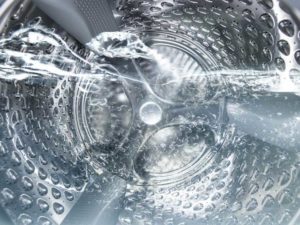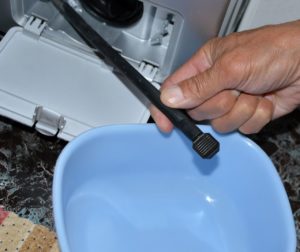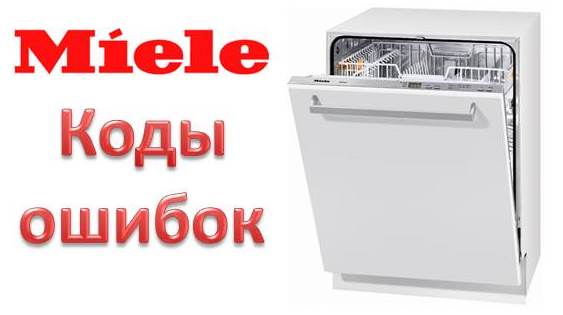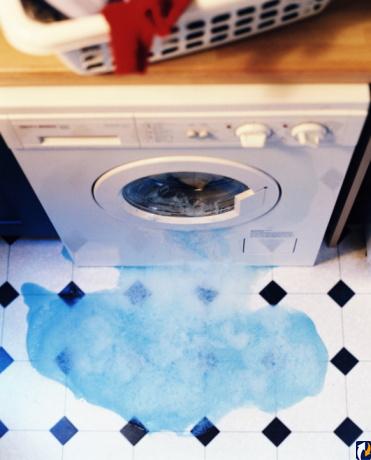Water remains in the washing machine drum after washing
 A washing machine breakdown can be a disaster for the modern busy person. However, not in all cases you should panic and sound the alarm by calling a specialist. Sometimes the problem is solved on its own in just 10-20 minutes. What should you do if there is water left in the washing machine drum after the end of the program? We will answer this question.
A washing machine breakdown can be a disaster for the modern busy person. However, not in all cases you should panic and sound the alarm by calling a specialist. Sometimes the problem is solved on its own in just 10-20 minutes. What should you do if there is water left in the washing machine drum after the end of the program? We will answer this question.
Causes of malfunction
If, after the end of the washing program, when you take out the laundry, you see that there is water left in the tank, then do not rush to panic. You need to carefully look at how much of this water is in the tank. The water might not drain completely, or it might remain partially. The reasons for this may be:
- the drain hose is kinked or severely clogged;
- The washing machine drain filter is clogged;
- if the water completely remained in the drum, and the machine hummed loudly during operation, then in 99 cases out of 100, this indicates a breakdown of the drain pump;
- when there is some water left in the drum, then in this case the pump is working, but the water level sensor is 95% likely broken.
Drain the water and fix the damage
Troubleshooting any malfunction should begin by disconnecting the washing machine from the electrical network and closing the water supply tap. Next, you need to check how the hose runs behind the machine body and whether it is kinked. And only after this we proceed to draining the water from the machine, having prepared a bucket, a low container and rags for this.
 Water can be drained through the drain hose by removing it from the siphon and lowering the bucket. This will also check if there is a blockage in the hose itself. If the water comes out normally, then the hose is clean and after draining the water, you can reconnect it. Otherwise, the water problem in the drum will be solved after cleaning the hose. To do this, you need to disconnect the second end of the hose from the machine, and then use a small brush on the cable to clean it and rinse it with water.
Water can be drained through the drain hose by removing it from the siphon and lowering the bucket. This will also check if there is a blockage in the hose itself. If the water comes out normally, then the hose is clean and after draining the water, you can reconnect it. Otherwise, the water problem in the drum will be solved after cleaning the hose. To do this, you need to disconnect the second end of the hose from the machine, and then use a small brush on the cable to clean it and rinse it with water.
If you managed to drain the water through the hose, then proceed to inspect the drain filter. It is located at the bottom of the machine behind a plastic panel or door. The filter must be unscrewed counterclockwise and pulled out towards you. If there is a blockage, rinse it under running water and put it back in place. If the filter is clean, then you will definitely have to check the drain pump.
Important! For emergency drainage of water in washing machines, there is a small hose that is located next to the drainage filter. It is enough to open the plug on it and place a container to drain the water from the tank.
The pump is installed differently on different washing machine models. In some washing machines, for example, Samsung and LG, this can be done through the bottom, but in German copies from Bosch and Siemens you will have to disassemble the front part, which complicates the repair process. The nuances of this work are described in detail in the article. Replacing the drain pump.
And finally, if the reason for the remaining water in the drum of the washing machine is the ineffective operation of the pressure switch, then you will have to check it too. If the pressure switch sends an incorrect signal about the water level in the tank during the draining process, then naturally there will be water left in the tank. How to check its performance? To do this you need:
- remove the top cover of the washing machine body;

- find the level sensor, usually located at the top in the corner of the machine;
- disconnect the tube (hose) and wires;
- inspect the tube for blockages, very often this is what causes the sensor to not work correctly;
- inspect the contacts and clean them if necessary;
- use a multimeter to check the resistance of the water level sensor;
Important! You should not blow air into it to check the pressotate, this can lead to its breakage. The fact is that there are different sensors, for example, analog.
- in case of malfunction, replace it with a new original sensor, connecting it to the tube, to the wires and screwing it into place.
Fault prevention
Recently, service center technicians have noted that breakdowns of drain pumps in new washing machines have become more frequent and occur already after 2-3 years of use. This may be due to low-quality components, or possibly due to the installation of the machine, when the drain hose is significantly extended, thereby increasing the load on the drain pump. That is why we draw your attention to the fact that you must follow the manufacturer's installation recommendations.
In most cases, problems with blockages can also be avoided if you adhere to the following rules:
- Before washing, check the pockets of items for debris and foreign objects;
- wash the drainage filter regularly;
- Clean the washing machine, for example, using citric acid or special products.
So, the water remaining in the drum after washing is a sign of some kind of malfunction that must be resolved immediately. If you start looking for the cause, and even more so you are afraid of repairing the machine, then at least before the technician arrives, you need to drain the water from the washing machine. This will prevent the appearance of an unpleasant odor inside the tank. You can definitely handle this.
Interesting:
1 reader comment
Add a comment Cancel reply
Categories
Washing machine repair


For buyers

For users

Dishwasher

















Nice and clear video, thank you!